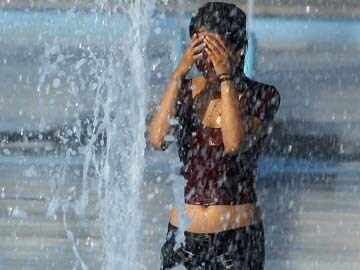
A girl cools off in the Unisphere fountain at the Flushing Meadows-Corona Park in the Queens borough of New York on July 22, 2011
New York:
The old adage, "it's not the heat, it's the humidity," will come into play more often and in more places because of climate change, with life-altering results in southern U.S. cities from Miami to Atlanta to Washington and even northern ones such as New York, Chicago and Seattle.
"As temperatures rise, toward the end of the century, less than an hour of activity outdoors in the shade could cause a moderately fit individual to suffer heat stroke," said climatologist Robert Kopp of Rutgers University, lead scientific author of the report. "That's something that doesn't exist anywhere in the world today."
That result emerges from the heat-and-humidity analysis in "Risky Business," the report on the economic consequences of climate change released on Tuesday. The analysis goes beyond other studies, which have focused on rising temperatures, to incorporate growing medical understanding of the physiological effects of heat and humidity, as well as research on how and where humidity levels will likely rise as the climate changes. [ID:nL2N0P40VR]
The body's capacity to cool down in hot weather depends on the evaporation of sweat. That keeps skin temperature below 95 degrees Fahrenheit (35 Celsius). Above that, core temperature rises past 98.6F. But if humidity is also high, sweat cannot evaporate, and core temperature can increase until the person collapses from heat stroke.
"If it's humid you can't sweat, and if you can't sweat you can't maintain core body temperature in the heat, and you die," said Dr Al Sommer, dean emeritus of the Bloomberg School of Public Health at Johns Hopkins University and author of a chapter on health effects in the new report.
The highest heat-plus-humidity reading in the United States was in 1995 in Appleton, Wisconsin, when the outside temperature was 101F. While the Upper Midwest is not known for tropical conditions, climate research shows that it will experience more warming than lower latitudes as well as more humidity.
As a result, the deadliest heat-and-humidity combinations are expected to center around that region, with threads reaching to the Eastern Seaboard and islands of dangerous conditions along the northwest Pacific coast.
If climate change continues on its current trajectory, the report concluded, Midwesterners could see deadly heat-and-humidity pairings (which meteorologists call "wet-bulb temperature") two days every year by later this century.
"It will be functionally impossible to be outside, including for things like construction work and farming, as well as recreation," said climate scientist Michael Oppenheimer of Princeton University.
Even without killer humidity, heat waves are expected to take a larger and larger toll.
The Southeast is expected to be hit with an additional 17 to 52 extremely hot days per year by mid-century and an additional 48 to 130 days by 2100. That could prove deadly for thousands: "Risky Business" projects an additional 15 to 21 deaths per 100,000 people every year from the heat, or 11,000 to 36,000 additional deaths at current population levels.
"As temperatures rise, toward the end of the century, less than an hour of activity outdoors in the shade could cause a moderately fit individual to suffer heat stroke," said climatologist Robert Kopp of Rutgers University, lead scientific author of the report. "That's something that doesn't exist anywhere in the world today."
That result emerges from the heat-and-humidity analysis in "Risky Business," the report on the economic consequences of climate change released on Tuesday. The analysis goes beyond other studies, which have focused on rising temperatures, to incorporate growing medical understanding of the physiological effects of heat and humidity, as well as research on how and where humidity levels will likely rise as the climate changes. [ID:nL2N0P40VR]
The body's capacity to cool down in hot weather depends on the evaporation of sweat. That keeps skin temperature below 95 degrees Fahrenheit (35 Celsius). Above that, core temperature rises past 98.6F. But if humidity is also high, sweat cannot evaporate, and core temperature can increase until the person collapses from heat stroke.
"If it's humid you can't sweat, and if you can't sweat you can't maintain core body temperature in the heat, and you die," said Dr Al Sommer, dean emeritus of the Bloomberg School of Public Health at Johns Hopkins University and author of a chapter on health effects in the new report.
The highest heat-plus-humidity reading in the United States was in 1995 in Appleton, Wisconsin, when the outside temperature was 101F. While the Upper Midwest is not known for tropical conditions, climate research shows that it will experience more warming than lower latitudes as well as more humidity.
As a result, the deadliest heat-and-humidity combinations are expected to center around that region, with threads reaching to the Eastern Seaboard and islands of dangerous conditions along the northwest Pacific coast.
If climate change continues on its current trajectory, the report concluded, Midwesterners could see deadly heat-and-humidity pairings (which meteorologists call "wet-bulb temperature") two days every year by later this century.
"It will be functionally impossible to be outside, including for things like construction work and farming, as well as recreation," said climate scientist Michael Oppenheimer of Princeton University.
Even without killer humidity, heat waves are expected to take a larger and larger toll.
The Southeast is expected to be hit with an additional 17 to 52 extremely hot days per year by mid-century and an additional 48 to 130 days by 2100. That could prove deadly for thousands: "Risky Business" projects an additional 15 to 21 deaths per 100,000 people every year from the heat, or 11,000 to 36,000 additional deaths at current population levels.
© Thomson Reuters 2014
Track Latest News Live on NDTV.com and get news updates from India and around the world

